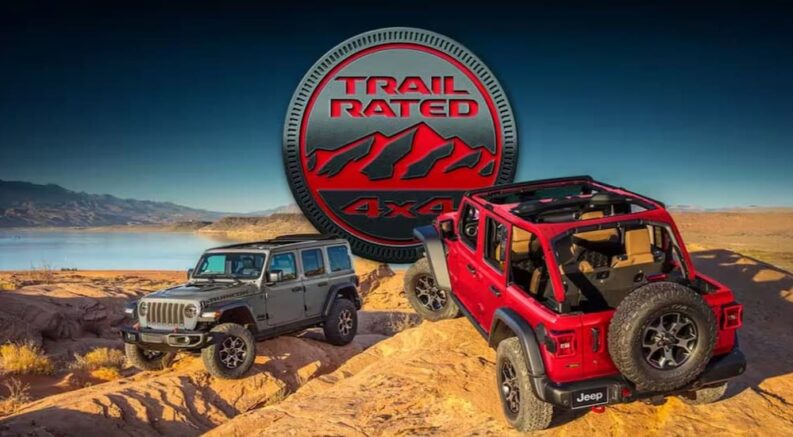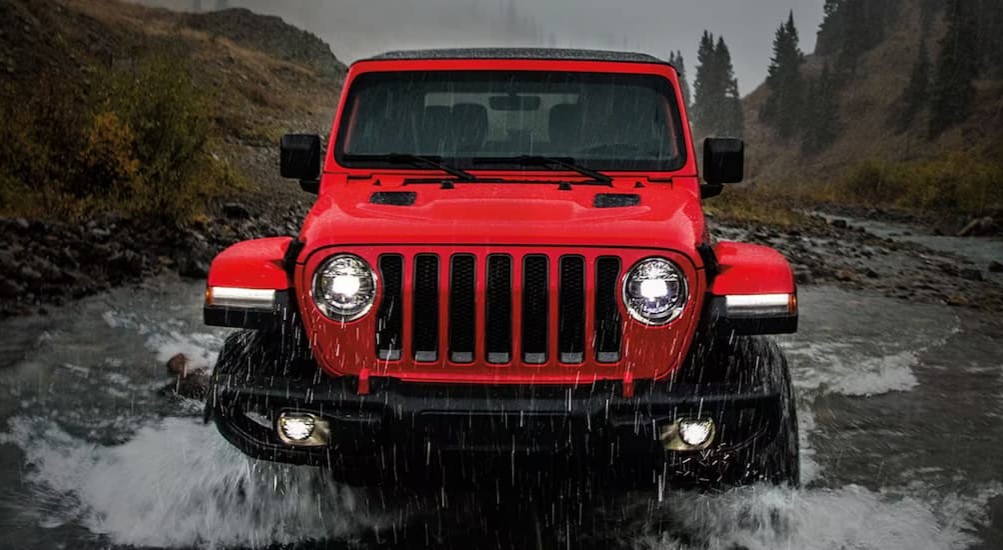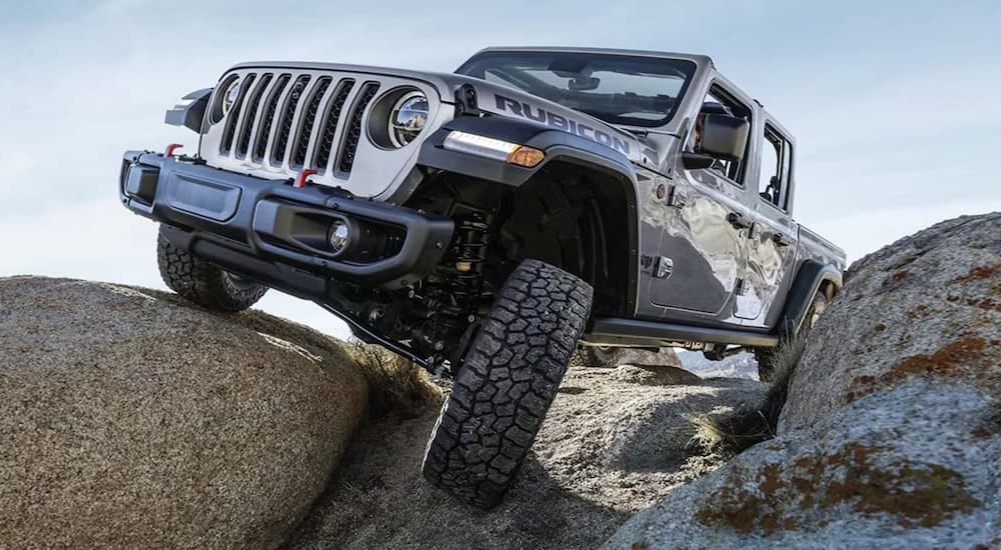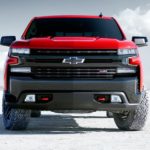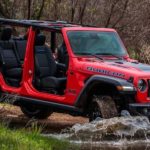Look closely the next time a Jeep vehicle pulls up to you at a red light. In addition to the seven-slot grille and timeless utilitarian design, you may notice a badge that sets these models apart from the rest: Trail Rated. It isn’t something that’s printed and slapped onto every Jeep that rolls off the assembly line. This badge is earned, showing that the model that proudly wears it can withstand some of the most challenging conditions known to man.
The Jeep Trail Rated Badge sets the Jeep brand apart from its rivals. Adventure enthusiasts demand Trail Rated vehicles when it comes to cascading through water, rolling over rocky terrain, and navigating some of the trickiest environments in existence.
About the Trail Rated Badge
The Trail Rated badge of honor first appeared in 2004 to signify which vehicles could withstand treacherous elements. It helped drivers know which models to choose when they required off-road excellence. To show off the Trail Rated badge on its body, a Jeep must perform impressively through a series of rigorous tests to ensure that it’s ready for anything that comes its way out on the trails and beyond.
It’s a common misconception that all Jeep models ever made are Trail Rated. Those who wear this badge proudly have been put to the test, earning this badge, rather than expecting it. From rugged and ready-for-anything adventure mates to family-friendly vehicles and daily commuters, a variety of Jeep models have earned this prestigious honor. This makes the Jeep brand one of the most diverse brands on the market, with everyday vehicles that can also tackle tough terrain with precision, making it the ideal lineup for drivers who demand more out of their vehicles.
Trail Rated Tests
Early on, all that was necessary to earn a Trail Rated badge was four-wheel drive and a two-speed transfer case with low range. However, as time has passed, Jeep has tightened its standards for this rating so that only the best-performing off-roaders earn it.
There are five tests that Jeep models need to pass to earn this respected badge. The tests are set up so that these models can show drivers that they’re up to the task of navigating more difficult terrain without letting them down. After all, the drivers that Jeeps appeal to are mainly those who require vehicles that can hold their own when the ground gets gritty, and drivers need to know if a model can’t perform under these pressures. Let’s discuss what each test consists of to better understand the process.
Traction
Trail Rated vehicles can handle normal driving conditions like pros, but what about when the surface beneath their tires becomes uneven, slippery, muddy, or sandy? This is where ample traction comes in to save the day, and Trail Rated Jeeps must prove that they can offer enough traction to help drivers confidently power over obstacles. Through a variety of 4×4 systems, Jeep Trail Rated vehicles send the right amount of power to the right wheels to take on rocky environments, slippery situations, sandy terrain, and a host of other surfaces with precision without slipping and sliding around and risking driver safety.
Water Fording
Whether it’s a flooded street or a small lake that has appeared on the trails, drivers don’t want to find themselves in a vehicle that can’t handle watery situations. Thanks to Jeep Trail Rated models’ design elements, fording up to 19 inches of water is no sweat for these seasoned explorers. You’ll find that Trail Rated vehicles showcase high ground clearance, as well as high air intakes to ensure that performance doesn’t suffer when navigating a bit of water. These models also include sealed body openings and sealed electrical connections to ensure that no water gets into these areas and affects the important components that lie within.
Ground Clearance
It’s not just water that requires a vehicle to be higher off the ground. An off-road vehicle may travel over rocks, tree limbs, and other obstacles that typically lie off the beaten path. This requires a vehicle that’s high enough off the ground to roll over these obstacles without being phased. That is what drivers can expect from Trail Rated Jeeps, which have at least 8.5 inches of ground clearance. These models offer improved approach and departure angles of at least 30 degrees to help them over obstacles without a struggle. This high ground clearance protects vital components from damage as well, making it easy for off-road enthusiasts to take to the trails without having to worry about damaging their vehicles.
Articulation
It’s true that you can take other vehicles on uneven terrain. However, it doesn’t mean that these vehicles can handle it, nor does it mean that drivers are going to be comfortable. Trail Rated Jeeps feature enhanced articulation, allowing them to sail over some of the roughest terrains imaginable, all without rocking the boat and tossing their occupants around like fish out of water. Through flexible suspension systems and exceptional wheel articulation, Trail Rated Jeeps showcase ample stability, even if their wheels aren’t all on the ground. This not only makes for a more enjoyable ride, but a safer and more controlled one as well.
Maneuverability
Traveling through the woods means that there’s bound to be obstacles in the way. A downed tree branch or a dense patch of forest requires expert maneuverability, which is to be expected in Trail Rated Jeeps. With accurate steering and wheelbases made for adventure, Trail Rated Jeeps are able to expertly navigate virtually any situation off-road, ducking and dodging obstacles with extreme precision. This allows adventure enthusiasts to be able to explore further into the wilderness without having to worry about damaging their vehicle or getting stuck in a tricky situation.
Why Drivers Choose Trail Rated Jeeps
As you can see, this is quite a test to put a vehicle through, which is why not every Jeep is considered Trail Rated. This may be fine for some, especially those who typically find themselves on the pavement, traveling to work, school, or after-school activities. Those who do require Trail Rated capabilities tend to find themselves exploring out in the wilderness, in the desert, and in areas that other vehicles just can’t navigate through. This calls for Trail Rated capabilities, making it easy for these drivers to maneuver through various obstacles that await them, whether that’s a flooded trail, a rocky ravine, or a slippery slope. A Trail Rated vehicle offers the control, stability, and confidence that drivers are seeking out, especially when navigating more dangerous environments.
The Jeep Trail Rated badge is not for everyone, and it’s certainly not for the weak. Vehicles with this badge have withstood some of Mother Nature’s most treacherous environments and come out on the other side unscathed. This badge is a testament to Jeep’s unrivaled reputation in the industry, offering models that are built differently and appeal to drivers with unique demands behind the wheel. Standing up to these tests and passing them with flying colors makes it easy for off-road enthusiasts to choose the best Jeep for them. As the years go on, you’ll see even more Jeep models showing off this badge as Jeep engineering and design continue to improve.

